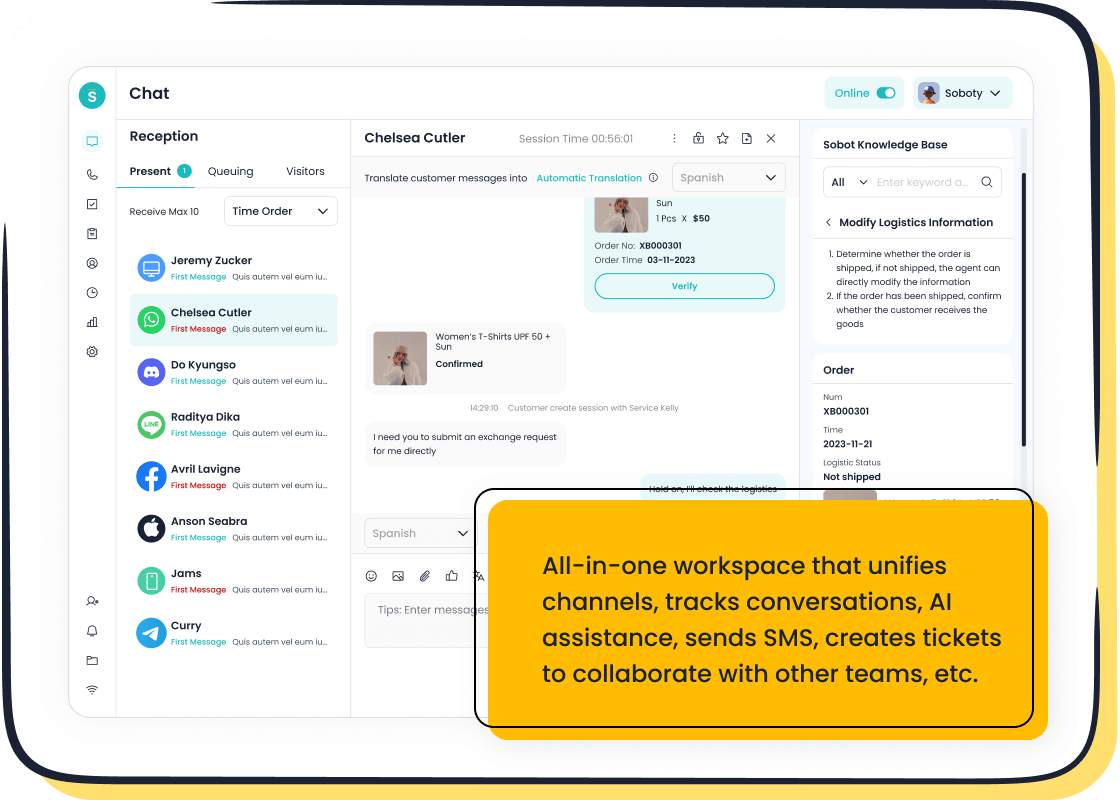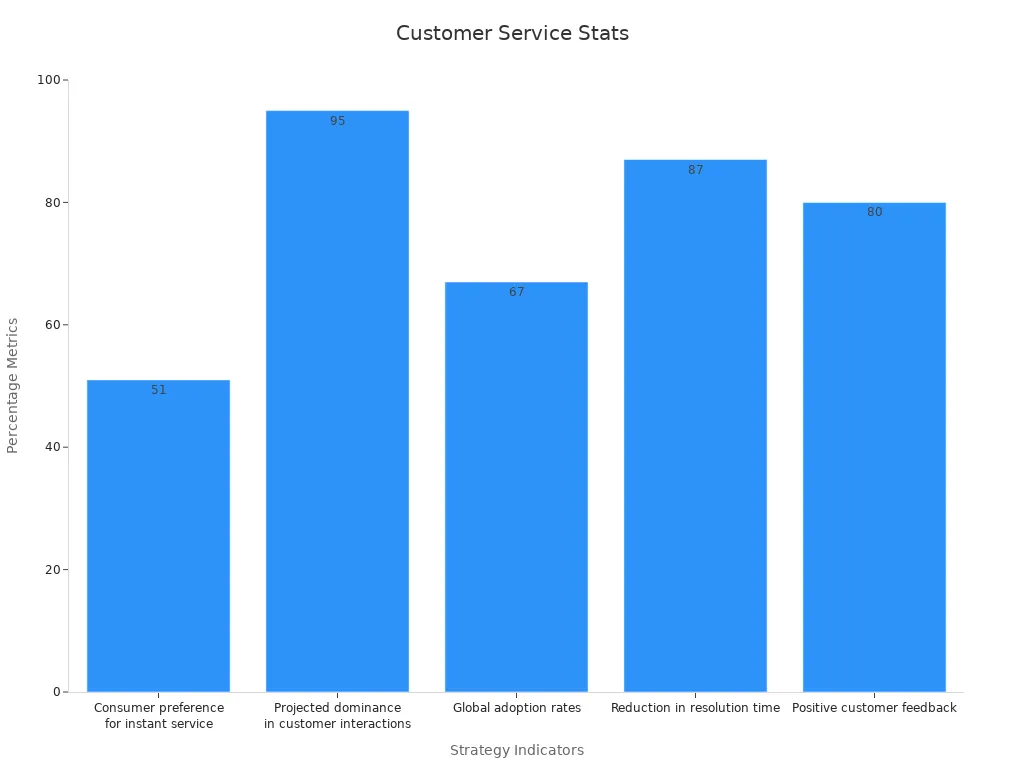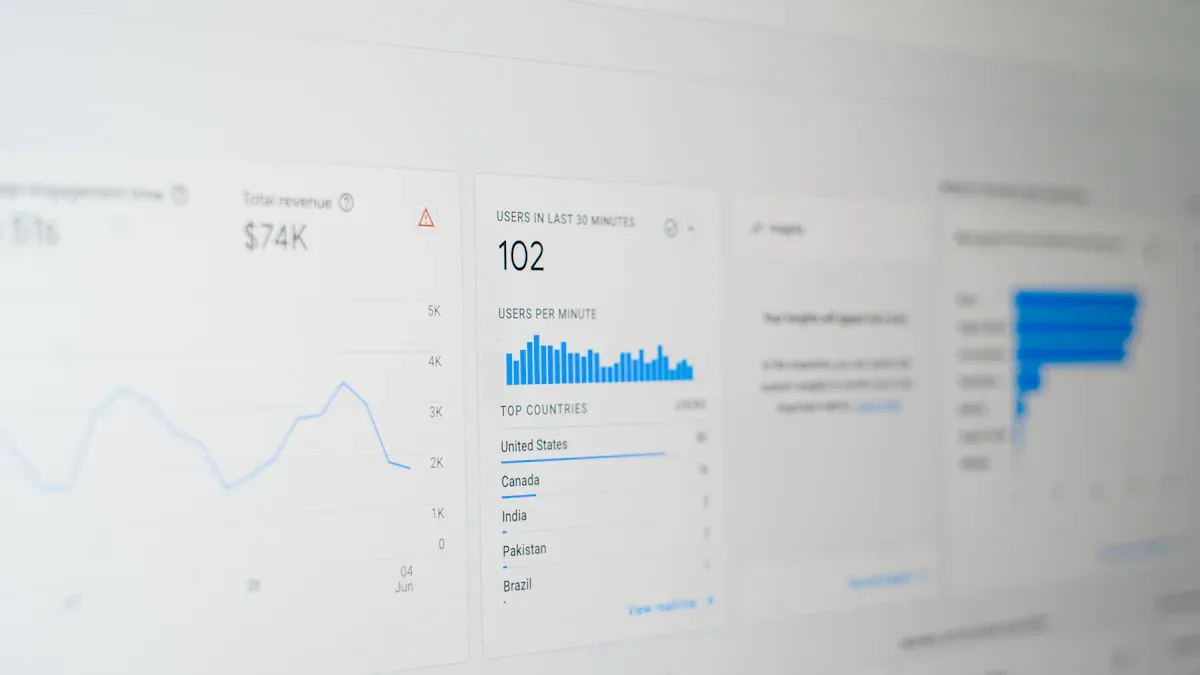Top Tips for Improving E-commerce Customer Experience

In e-commerce, customer experience isn’t just a buzzword—it’s a game-changer. When you deliver a seamless, personalized journey, your business thrives. Did you know that companies excelling in customer experience achieve revenues 4-8% higher than their competitors? Or that 86% of people will pay more for a great experience? By focusing on what your customers truly want, you can build loyalty that lasts. Tools like Sobot make it easier by helping you understand how to improve ecommerce customer experience and turn casual shoppers into lifelong fans.
Understanding How to Improve E-commerce Customer Experience
Defining Customer Experience in E-commerce
Customer experience in e-commerce is all about how your customers feel when interacting with your online store. It includes every touchpoint, from browsing your website to receiving their order. A positive experience means smooth navigation, secure payments, fast shipping, and personalized recommendations. Imagine walking into a store where everything is tailored to your preferences—that’s what your e-commerce site should feel like.
To create this kind of experience, you need to understand your customers. Use data analysis, feedback, and market research to uncover what they want. Then, tailor your products, services, and interactions to meet their needs. When you prioritize their satisfaction, you’re not just selling products—you’re building relationships.
Why Customer Experience is Key to Customer Satisfaction and Loyalty
Why does customer experience matter so much? Because it directly impacts customer satisfaction and loyalty. When your customers feel valued, they’re more likely to stick around. Did you know that 65% of customers stay loyal because of positive service experiences? And 44% of online shoppers are more likely to return after a personalized experience.
Personalization is a game-changer. Customers expect it—73% of them, to be exact. If you don’t meet these expectations, you risk losing them. On the flip side, great experiences encourage repeat purchases and even turn customers into brand advocates. By focusing on how to improve ecommerce customer experience, you’re not just improving satisfaction—you’re securing long-term loyalty.
Common Standards for Measuring Customer Experience
How do you know if your customer experience strategies are working? You measure it. Here are some common metrics used in e-commerce:
| Metric | Description |
|---|---|
| Net Promoter Score (NPS) | Measures how likely customers are to recommend your brand. |
| Customer Satisfaction (CSAT) | Gauges satisfaction through surveys. |
| Customer Effort Score (CES) | Evaluates how easy it is for customers to interact with your brand. |
| Customer Retention | Tracks how well you keep customers over time. |
| Customer Lifetime Value (CLV) | Calculates the total revenue a customer generates during their relationship with your brand. |
These metrics give you a clear picture of what’s working and what needs improvement. For example, a high NPS means your customers are happy and willing to recommend you. On the other hand, a low CES might indicate friction in your processes. By keeping an eye on these numbers, you can continuously refine your strategies to improve customer satisfaction.
Personalization Strategies for Boosting Customer Satisfaction

Using Data to Understand Customer Preferences
Understanding your customers starts with data. Every click, search, and purchase tells a story about what they want. By analyzing this data, you can uncover patterns and preferences that help you deliver a more tailored shopping experience. For example, advanced analytics can reveal which products are trending, predict demand, and even identify customer pain points.
Did you know that personalized product recommendations contribute to 26% of all e-commerce revenue? This shows how impactful data-driven personalization can be. When you aggregate data from multiple channels—like your website, social media, and email campaigns—you get a complete picture of your customers. This omnichannel approach not only enhances customer satisfaction but also builds trust.
Sobot’s AI solutions make this process seamless. By integrating data from various platforms, Sobot helps you understand buyer behavior and create personalized interactions. Whether it’s through chat, email, or social media, you can connect with your customers in meaningful ways.
Implementing Personalized Product Recommendations
Personalized product recommendations are a game-changer in e-commerce. They guide customers toward items they’re most likely to buy, making their shopping journey smoother and more enjoyable. Imagine visiting an online store and seeing a “Recommended for You” section filled with items that match your style or past purchases. That’s the power of personalization.
Studies show that 80% of consumers are more likely to purchase when offered personalized experiences. Additionally, businesses using personalized recommendations see higher conversion rates and average order values. For instance, a home decor site increased its average order value by 12% and customer engagement by 20% using machine learning to suggest products.
Sobot Live Chat takes this a step further. With features like customer segmentation and AI-assisted tools, it enables you to offer real-time, tailored recommendations. This not only improves customer satisfaction but also boosts sales. By turning browsers into buyers, you can enhance customer satisfaction and drive revenue growth.
Tailoring Marketing Messages and Offers with Sobot Live Chat
Generic marketing messages no longer cut it. Customers expect brands to speak directly to them, addressing their unique needs and preferences. Tailored marketing messages and offers can significantly improve engagement and loyalty. For example, an online bookstore increased social media engagement by 40% and website traffic by 35% by using sentiment analysis to craft personalized content.
Sobot Live Chat makes this level of personalization easy. Its omnichannel support allows you to interact with customers on their preferred platforms, whether it’s WhatsApp, Instagram, or your website. With built-in analytics, you can segment your audience and send targeted offers that resonate. For instance, you can identify VIP customers and provide them with exclusive discounts or early access to new products.
The results speak for themselves. Businesses using Sobot’s intelligent solutions have seen a 22.2% increase in independently answered customer questions, with a CSAT score of 97%. By leveraging tools like Sobot Live Chat, you can create personalized experiences that not only meet but exceed customer expectations.
Enhancing Customer Service to Build E-commerce Customer Loyalty
Importance of Responsive and Friendly Support
Exceptional customer service is the backbone of e-commerce customer loyalty. When customers feel heard and valued, they’re more likely to return and recommend your brand. Imagine this: you’re shopping online, and you encounter an issue. Wouldn’t you appreciate quick, friendly assistance? That’s exactly what your customers expect.
Responsive support isn’t just about speed—it’s about empathy. A study found that 59% of customers stop doing business with a brand after several bad experiences. Even one negative interaction can drive away 32% of customers. To avoid this, focus on creating a positive experience every time. Train your team to handle inquiries with patience and professionalism. Use tools like live chat to provide instant solutions.
Friendly support builds trust, which is essential for customer loyalty. When customers know they can rely on you, they’ll stick around. This trust translates into repeat purchases and glowing reviews, helping you grow your business.
Leveraging Sobot Live Chat for Instant Assistance

In today’s fast-paced world, customers want answers now—not later. That’s where Sobot Live Chat shines. It’s designed to provide instant, personalized assistance across multiple channels, including websites, apps, and social media platforms like WhatsApp and Instagram.
Why does instant assistance matter? Studies show that 51% of consumers prefer bots over humans for immediate help. AI-powered tools like Sobot Live Chat can handle up to 80% of routine tasks, freeing your agents to focus on complex issues. For example, Lyft reduced its resolution time by 87% using AI-driven customer service solutions.
Sobot Live Chat offers features like omnichannel support, AI-assisted tools, and customer segmentation. These tools help you deliver tailored solutions in real-time, boosting customer satisfaction. Businesses using Sobot have reported a 38% increase in conversion rates and a 97% customer satisfaction score.

By leveraging Sobot Live Chat, you can turn inquiries into opportunities to build loyalty. Instant assistance isn’t just a convenience—it’s a competitive advantage.
Best Practices for Handling Customer Complaints
Handling complaints effectively is crucial for improving customer satisfaction and fostering loyalty. When customers voice concerns, they’re giving you a chance to fix the problem and strengthen the relationship. Here’s how you can do it:
- Listen and empathize: Show customers you care about their experience. A simple apology can go a long way.
- Act quickly: Resolve issues as soon as possible. Delays can frustrate customers and damage your reputation.
- Offer solutions: Provide refunds, replacements, or discounts when necessary. This demonstrates your commitment to customer satisfaction.
- Gather feedback: Use online surveys, social media, and website analytics to understand customer needs and identify areas for improvement.
For example, ensuring accurate delivery estimates and secure packaging can prevent complaints about shipping. If an item gets lost, apologizing and offering a refund can turn a negative experience into a positive one.
Remember, every complaint is an opportunity to learn and grow. By addressing issues effectively, you can improve customer satisfaction and build lasting loyalty.
Leveraging Feedback and Reviews to Improve Customer Experience
Encouraging Customers to Share Feedback
Feedback is a goldmine for understanding how to improve ecommerce customer experience. When customers share their thoughts, they give you a roadmap to refine your services and products. But how do you encourage them to speak up? Start by making it easy. Add feedback forms to your website, send follow-up emails after purchases, or use tools like Sobot Live Chat to ask for input during interactions.
Why is this important? Feedback helps you assess your performance and identify areas for improvement. Studies show that 53% of customers expect businesses to act on their feedback. Engaging with their opinions also personalizes their experience, fostering loyalty. For example, a clothing retailer used customer suggestions to redesign its size guide, reducing returns by 20%. By leveraging customer feedback, you can improve customer satisfaction and build stronger relationships.
Using Reviews to Build Trust and Credibility
Online reviews are the modern-day word of mouth. Up to 90% of customers read reviews before making a purchase, and 88% trust them as much as personal recommendations. This makes reviews a powerful tool for building trust and credibility in e-commerce.
Encourage satisfied customers to leave reviews by offering incentives like discounts or loyalty points. Once you collect reviews, showcase them prominently on your website and social media. Positive reviews not only reassure potential buyers but also improve your search engine rankings. Analytical reports show that monitoring and responding to reviews helps maintain a positive brand image. Tools like Sobot’s AI solutions can analyze reviews to identify trends and address concerns promptly, ensuring your reputation stays strong.
Turning Negative Feedback into Opportunities for Growth
Negative feedback might sting, but it’s a chance to grow. When customers point out flaws, they’re giving you an opportunity to fix them. For instance, a leading electronics company analyzed 5,000 reviews and discovered that 75% of complaints were about product usability. By addressing this issue, they increased customer retention by 30%.
The key is to act quickly. Apologize, offer solutions, and show customers you’re committed to improvement. Sobot’s AI tools can help you track and categorize complaints, making it easier to spot recurring issues. A mid-sized restaurant chain trained its staff to handle complaints effectively, reducing repeat issues by 50% and boosting its ratings. By turning criticism into action, you can improve customer satisfaction and strengthen loyalty.
Optimizing the User Journey for Seamless Shopping Experiences

Simplifying Website Navigation and Checkout Processes
Your website’s navigation and checkout process can make or break the shopping experience. When customers can easily find what they need and complete their purchase without hassle, they’re more likely to return. Research shows that effective navigation reduces frustration, while a seamless checkout process lowers cart abandonment rates.
Here’s how you can simplify these critical steps:
- Streamline navigation: Use clear categories and intuitive menus to guide customers.
- Optimize search functionality: Include filters and predictive search to help users find products faster.
- Simplify checkout: Minimize the number of steps and fields required to complete a purchase.
Take inspiration from companies like Expedia, which removed one unnecessary field from its checkout process and saw a $12 million profit increase. Similarly, Crazy Egg boosted conversions by 30% by eliminating redundant form fields. These examples highlight how small changes can lead to big results.
| Company | Change Made | Result |
|---|---|---|
| Expedia | Removed one field (company name) from checkout | $12 million increase in profit |
| Crazy Egg | Removed unnecessary form fields | 30% increase in conversions |
Ensuring Mobile-Friendly Design
Mobile commerce is booming, and your e-commerce site needs to keep up. With 79% of smartphone users making online purchases in the last six months, optimizing for mobile isn’t optional—it’s essential.
What does a mobile-friendly design look like? It’s responsive, fast, and easy to navigate. Amazon achieved a 15% increase in mobile conversion rates after implementing a fully responsive design. Nike saw a 25% drop in bounce rates and a 20% rise in mobile sales by enhancing its mobile site performance.
To optimize your site for mobile:
- Use responsive design to ensure your site adapts to different screen sizes.
- Improve load times by compressing images and minimizing code.
- Simplify navigation with larger buttons and clear menus.
By focusing on mobile user experience optimization, you’ll not only enhance customer satisfaction but also stay competitive in the fast-paced e-commerce landscape.
Reducing Page Load Times and Technical Errors
Slow pages and technical glitches frustrate customers and hurt your bottom line. A one-second delay can reduce conversions by up to 7%. Walmart reported a 2% increase in conversions for every one-second improvement in page load time.
To optimize performance:
- Monitor key metrics: Keep your Largest Contentful Paint (LCP) under 2.5 seconds and First Input Delay (FID) below 100 milliseconds.
- Minimize server response time: Reduce Time to First Byte (TTFB) for faster loading.
- Ensure content stability: Avoid layout shifts during loading to improve Cumulative Layout Shift (CLS).
Pinterest reduced perceived wait times by 40%, leading to a 15% increase in SEO traffic. These results show how reducing page load times and fixing errors can directly impact your e-commerce success.
Tip: Regularly test your site’s performance using tools like Google PageSpeed Insights to identify and resolve issues quickly.
Loyalty Programs and Incentives to Foster E-commerce Customer Loyalty
Designing Effective Loyalty Programs
A well-designed loyalty program can transform casual shoppers into loyal customers. To create one, focus on personalization, engagement, and clear rewards. Use customer data to tailor rewards based on shopping habits. For example, offering discounts on frequently purchased items shows you understand their preferences.
Structure your program to guide customers while giving them choices. Curated reward options based on behavior make them feel valued. Add progress trackers to show milestones and upcoming rewards. This motivates customers to stay engaged. Starbucks Rewards is a great example. Customers earn points for purchases, redeemable for free items, which keeps them coming back.
Community-building elements also work wonders. Member-only forums or events foster a sense of belonging. According to Accenture, loyalty program members generate 12-18% more revenue than non-members. By designing programs with intention, you can boost e-commerce customer loyalty and drive repeat business.
Offering Exclusive Discounts and Rewards
Exclusive discounts and rewards make customers feel special. When they know they’re getting something unique, they’re more likely to stick with your brand. Amazon Prime is a prime example (pun intended). Members enjoy free shipping and exclusive deals, which encourages higher spending.
Statistics back this up. Improving customer retention by just 5% can increase net revenues by 25%. Customers who feel valued are 82% more likely to repurchase. You can offer tiered rewards to incentivize spending. For instance, higher tiers could unlock bigger discounts or early access to new products.
Frame rewards as experiences rather than just monetary value. A VIP shopping event or personalized thank-you note can leave a lasting impression. By offering exclusive perks, you’ll not only retain loyal customers but also strengthen their emotional connection to your brand.
Encouraging Repeat Purchases Through Incentives
Incentives are powerful tools for encouraging repeat purchases. Programs with tiered memberships report a 30% higher retention rate. Personalized rewards can increase consumer spending by up to 40%. Align cashback offers with purchase frequencies to maximize engagement.
Timing matters too. Offer rewards during peak shopping periods or after significant milestones. Behavioral triggers like “Buy two, get one free” promotions can nudge customers toward repeat purchases. Loyalty programs tap into the psychological need for recognition, making customers feel valued.
Leverage data analytics to identify what your customers value most. For example, if convenience is key, offer free shipping or faster delivery options. By aligning incentives with customer needs, you’ll foster e-commerce customer loyalty and encourage long-term engagement.
Improving your e-commerce customer experience doesn’t have to be complicated. Focus on these key strategies:
- Personalize every interaction to make customers feel valued.
- Offer responsive, friendly support to build trust.
- Use feedback and reviews to refine your services.
- Create loyalty programs that reward repeat purchases.
Pro Tip: Small changes, like faster response times or tailored offers, can make a big difference.
Start implementing these tips today. When you prioritize customer satisfaction, you’ll see stronger loyalty, better reviews, and higher sales. Your customers will thank you—and so will your bottom line!
FAQ
What is the best way to improve the customer journey in e-commerce?
Focus on personalization and seamless navigation. Use tools like Sobot Live Chat to provide customized communication and instant support. A smooth customer journey builds trust and encourages repeat visits, enhancing customer retention and satisfaction.
How can I measure the success of my customer journey improvements?
Track metrics like customer retention, Net Promoter Score (NPS), and Customer Satisfaction (CSAT). These indicators show how well your strategies are working and highlight areas for improvement. Regularly reviewing these metrics ensures your customer journey stays optimized.
Why is customer retention important for e-commerce success?
Customer retention drives long-term growth. Retaining customers costs less than acquiring new ones and boosts revenue. Loyal customers often become brand advocates, increasing customer engagement and trust. A strong retention strategy ensures consistent business growth.
How does Sobot Live Chat enhance customer engagement?
Sobot Live Chat offers real-time, customized communication across multiple channels. It helps you connect with customers instantly, resolving issues and answering questions. This personalized approach improves customer engagement and strengthens loyalty.
What role does feedback play in improving the customer journey?
Feedback helps you understand customer needs and pain points. Use it to refine your processes and enhance the customer journey. Acting on feedback shows customers you value their opinions, which fosters trust and loyalty.
See Also
10 Strategies To Improve Customer Satisfaction Through Live Chat
The Role Of Chatbots In Enhancing E-commerce Satisfaction
Increasing Sales With Effective E-commerce Live Chat Solutions
